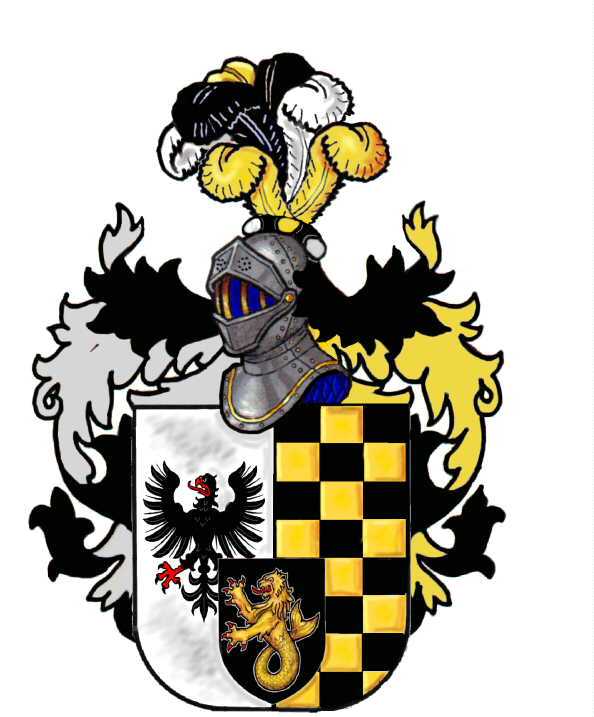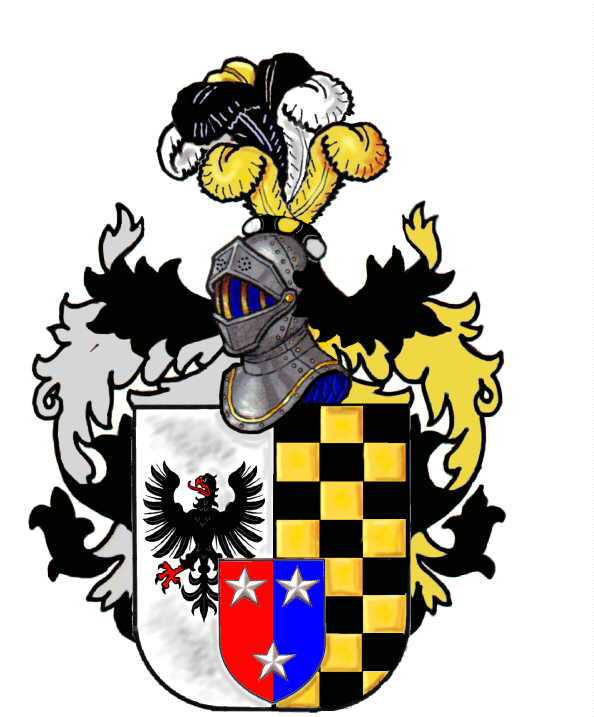SURNAME LIST
NAME INDEX
SOURCES
EMAIL US


Coat of Arms
Roco & de Roco
Let me begin with, three people, two trained as heralds, Don Pepe Casas who lives in Mexico and Spain, and Jude Grupe in the Philippines, along with a man who is a German Heraldist in Westfalen Germany, Herr Michael Waas, who is the Principal Pursuivant & Marsheal of Arms, Heraldische Gemeinshaft Westfalen ( The Westphalian Heraldry Society). These three men put their heads together, along with a little research on my part, and as a favor to me, discovered that the Rocos and de Rocos came from "Extremaduro Spain". They were "Extremeños". This was discovered in a Heraldric book called "Heraldica 11", written by Julio Olmedo Alvares and Joaquin Diaz Valles, and published by Perea Ediciones. There displayed on page 95, along with other Coats of Arms, was the Roco Coat of Arms. They also found that the Roco (with one "C") who was granted this, was named Bernardo Roco. He was a "Conquistador" from the "Villa de Alcántara" in Extremadura. He was married to Maria Alonso de Pimentel. They had three sons, Martin Roco, Diego Roco, and Miguel Roco. Bernardo and his three sons died in the battle of Sevilla in 1248. Bernardo Roco was descended from the "Condes de Urgel" which were descended from the Counts of Barcelona and Carcassone, which goes back to as early as 812 AD. Urgel is now a city, a few miles from Andorra Spain. Urgel was ruled by the Bishop of Urgel, who was given this land by the King of Spain.
It was found also, that it was the custom during the time when the Holy Roman Empire of Germany ruled Spain and Italy, under the Saxon King Otto 1 who established the Holy Roman Empire of Germany in alliance with Pope John XII, and after Frederick II died (1194-1250), that Spanish and Italian noblemen were given the preface "de" in front of their surnames. That does not mean we are of Royal blood, but we stem from what was considered a "Noble" at that time. So the "de" must have been awarded to a Roco sometime before 1791 when Don Tomas Manuel de Roco was born, because the family used "de Roco" at the time of his birth, as they still do in the USA. The Holy Roman Empire of Germany ruled until 1806AD. The earliest reference to "de Roco" that could be found was the son of Juan Martin Roco, who was married to Cecilia Fernández de Heredia. The son's name was Juan Martinez de Roco of Campofrio Spain, born in Alcántara Spain, but what year I do not know. The reason for the "de" I do not know, or why it was granted. His father, Juan Martin Roco, died in Alcántara on the 10th of June in 1401, according to the records that were found.
It must be remembered that a Coat of Arms is granted to Individuals, not families, at least in Spain and Italy. It was for identification, for deeds, mostly in battle, or for Station in Society. In today's world it would be like receiving a Medal of Honor, and belongs to a single person. However in those times, as it is today, the MALE descendents of the Coat of Arms recipient, could, and still can, display the Coat of Arms, and all of the family with the same surname, can display the Coat of Arms, to honor the recipient and to identify a certain family. In some Countries like England, only the eldest son had, and still has, that honor. That is not the case in Spain.
Jude Grupe and Don Pepe Casas, who is a friend of Don Alfonso de Ceballos-Escalera, Marques de la Floresta, who was appointed by King Juan Carlos and does Certifications, and Herr Michael Waas in Germany, found that the Rocos left Extremaduro, at least some of them, and migrated to middle Italy, somewhere around Naples. It must be remembered that Spain held Italy from around 1500 until somewhere around 1798, that is why both Facundo (Ding) Roco and myself are correct as far as the family is concerned, with some of the family in Spain, and some in Italy. But we All are of Spanish decent. Also there was for more than 200 years endless warfare between France, and the Holy Roman Empire (which Spain was a part of) and Austria over Middle Italy during that time. That explains why the Coat of Arms that was found was a mixture of different styles, Spanish AND Italian, for Roco. The particular Eagle shown on the Roco Coat of Arms is ONLY found on a shield from Italy. Both Italy and Spain were part of the Holy Roman Empire . Apparently our family fought, and was allied with the Holy Roman Empire against the French. That is why the shield shows Spanish and Italian markings, and is recorded in Germany. Also we must remember that although Spain and Italy were members of the Holy Roman Empire, it was ruled by the House of Habsburg in Austria for nearly 300 years, and all the records for that era are kept in Germany. Those were very turbulent times. Even the King of Spain in 1521 when the Philippines were discovered, was German, born in Ghent, in the Netherlands. A lot of the Spanish Grandes and Princes were granted titles during that time, and are recorded in the archives in Siebmacher Books in Germany. That is why, in this year 2003, our Spanish and Italian Coat of Arms will be recorded in The International Register of Arms in Bochum, Westphalia Germany, thanks to Herr Michael Waas, and Jude Grupe, with Sen.Raul Roco and myself as what are called "founders". That way ALL MALE Rocos, and de Rocos from this day forward, will legally have the right to display a Coat of Arms, registered in The International Register of Arms in Germany, based on the original Coat of Arms of Bernardo Roco, found in the book "Heraldica 11", page 95, in Spain. The only difference will be a small insert. For the de Rocos, there will be what is known as "A Bar and Mullets", and for Raul and all Rocos, the insert will have a "sealion" which was the symbol of Manila and the Archipelago originally granted by King Philip ll of Spain in 1596. The design and both helmets are medieval Spanish, and the Eagle is Italian, all taken from Bernardo Roco's original Coat of Arms.
The reason for both Raul and myself is simple. We are two different branches of the same family (Roco and de Roco). Senator Raul because he will be the future President of the Philippines (his station in society). Thus he represents all male "Rocos", and me, because to my knowledge, I am the oldest living male "de Roco".
To give you an example of how branches of a family must be recorded separately : In The Royal Family in England, the Queen, Philip the Duke of Edinburg her husband, Charles the Prince of Wales, and his son Prince William, all represent different branches of the Royal Family, and each has a slightly different Coat of Arms based on a Coat of Arms in the past. The reason for that is, in England, only the first born son can claim his father's Coat of Arms. We are NOT a Royal Family, nor are we English, but we are two different branches of the same family. Raul and myself as "founders" will show that the Rocos and the de Rocos, are the same family, and we are still "alive and well " in this year of 2003. That means ALL of us will be able to display our registered Coat of Arms, with pride, for the orginal recipient and ourselves, from the 16th of February 2003 for the "de Rocos", and the 18th of March 2003 for the "Rocos".
As of the above date, February 16th 2003, the Amorial Bearing for the "de Rocos" was Registered under numbers 10,000,203 and 1,810,143(Wappenrolle HGW) in Germany, and the "Roco" numbers were also regestered as of the 18th of March, and are in the hands of Sen. Raul and Carlos (Itos) Roco.
We must continue to have pride in our family. Our ancestors fought to obtain our Coat of Arms. Their shields identified them as respected men. We must respect the right that is ours, to display our pride for being a part of this family. Always keeping in mind that it is a responsibility that we should not take lightly. Going back from this year 2003, we now have proof that our wonderful family is One Thousand One Hundred and Ninety One years old.
Gentlemen, may God grant us the wisdom, by example, to pass on to our children what it means to be a Roco, or de Roco. To be a part of a wonderful family whose principles must always show that we too, are respected men, now and for generations to come.
Jack de Roco 2003